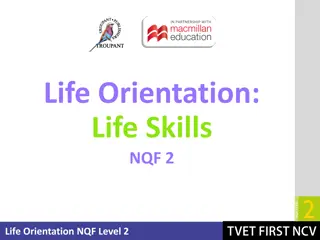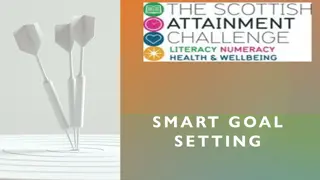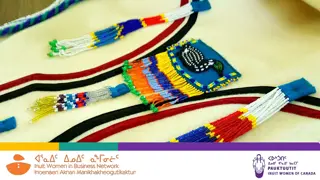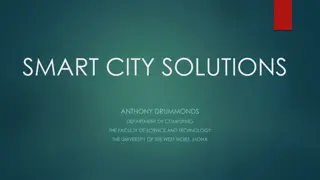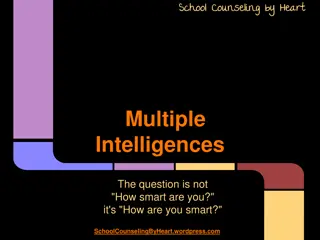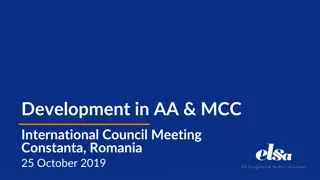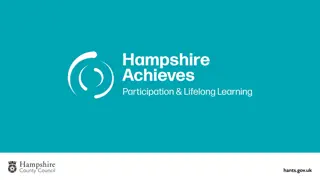SMART Goals in Writing
"Learn the importance of setting SMART goals when writing, driving treatment, organizing therapy, and tracking outcomes. Understand the components of SMART goals - specific, measurable, attainable, relevant, and timely - to help achieve success in goal setting and task accomplishment."
Download Presentation

Please find below an Image/Link to download the presentation.
The content on the website is provided AS IS for your information and personal use only. It may not be sold, licensed, or shared on other websites without obtaining consent from the author.If you encounter any issues during the download, it is possible that the publisher has removed the file from their server.
You are allowed to download the files provided on this website for personal or commercial use, subject to the condition that they are used lawfully. All files are the property of their respective owners.
The content on the website is provided AS IS for your information and personal use only. It may not be sold, licensed, or shared on other websites without obtaining consent from the author.
E N D
Presentation Transcript
Goal Writing 101 Being SMART About Goals
Sarah Getman MS, CCC-SLP Speech-Language Pathologist sarahg@fusionwebclinic.com
Importance of Goals Drive treatment Where the patient started and where they need to go Help organize our treatment Linear or hierarchical Path to development (or recovery) Outcomes of therapy Is it working? Unite the team Clinician, family, patient, etc. Clearly written goals facilitate passing of the baton
Specific Define the goal as much as possible Ask yourself the following questions: Who Who is involved? How What What do I want to accomplish? Where will it be done? Context? Specific Which skills that are lacking can I help the client attain? Where Why Which skills can be used to compensate for deficiencies? Which Why am I doing this (reasons, purpose)? How much assistance am I providing?
Measurable 100 80 Can you define the skill and can you measure that skill? How will you measure progress? Criteria for accomplishing goal? 60 40 20 0
Attainable, Relevant, & Timely Attainable Relevant Timely Can the patient accomplish this goal in a reasonable timeframe? Unattainable goals may lead to a negative attitudes toward therapy Will the accomplishment of this goal serve a function for the patient? Purpose and impact Consider limits of the diagnosis Cultural and social needs? Does the goal contain a timeframe? Date for accomplishing the goal? Can it be attained in that time frame?
Formatting Goals Performance What you expect the patient to perform Condition The condition under which the performance is done Criterion How well the patient is expected to perform
Example Sam will imitate /s/ in a CV syllable in 8/10 attempts Performance Condition Criterion Sam will imitate /s/ in a CV syllable in 8/10 attempts
Alternative Formatting C O A S T Specific Condition Client Occupation Assist Level Timeline Matt will feed self 50% of meal with min physical assistance to scoop using built-up spoon within 3 therapy sessions Within 3 therapy sessions, Matt will feed self 50% of meal using built-up spoon with min physical assistance to scoop
Fusion has significantly decreased the amount of time I spend doing paperwork! Nikki, Pediatric OT Advanced Therapy Solutions Learn more about how a pediatric-specific EMR will allow you to spend more time with your patients - and less time on documentation! Learn About Fusion Learn About Fusion
Goal Types Short-Term Goal Long-Term Goal (LTG) or Outcomes May take months or years to achieve Long-Term Goal Short-Term Goal (STG) or Objectives Objective that the patient must attain before achieving the LTG Steps taken to achieve the LTG Achieved in a shorter time period
Example LTG Emily will produce age appropriate sounds during conversational speech with 90% accuracy in order to communicate effectively with family and peers. Emily will produce /r/ correctly in the initial position of words, given instruction on proper tongue placement and modeling by the clinician, with 90% accuracy across three therapy sessions. STGs Emily will produce /s/ correctly in a CV syllable, given clinician modeling, with 90% accuracy across three therapy sessions. Emily will produce /l/ in the initial position of words in phrases with 80% accuracy given minimal verbal cues across 4 out of 5 therapy sessions.
Example LTG Brandon will independently maintain single limb stance for 3 sec with minimal lateral trunk lean to improve dynamic balance for age-appropriate gross motor skills. Brandon will navigate 5.5 inch balance beam on floor with tandem gait and no step offs with close stand by assistance, 80% of attempts. STGs Brandon will independently maintain static stance on unstable surface (bosu ball or airex pad) for 3 min while engaged in dynamic upper extremity reaching activities demonstrating improved ankle balance reactions for gait.
Example Henry will demonstrate age-appropriate visual motor skills by copying a circle, cross and square independently without any verbal or physical cues, 75% of the time over the next twelve months. LTG Henry will improve visual motor skills by cutting a 6-inch line within -inch of the line on first trial, 80% of the time over the next six months. STGs In order to facilitate more of a dynamic grasp, Henry will color a 2-inch round space within -inch of the boundary, 80% of the time within the next six months. Henry will complete a simple, 8 piece puzzle with 100% accuracy with no more than 2 verbal cues within the next six months.
Changing Goals in Fusion Editing Archiving May edit a goal if: Upgrading goal changing criterion Want to keep prior data points May archive a goal if: Goal has been met Goal is no longer appropriate Changing cueing or level of assistance E.g. Criterion started at 50% and you want to upgrade it to 80% Can always recover later if needed
Dont Miss Any of the Free Resources at FusionWebClinic.com Get More Free Pediatric Therapy Resources and Content Access Now Access Now
References Colburn, J. G. (2011). The small patient practice: a beginner's guide to starting a pediatric PT, OT or SLP solo practice, including medical documentation, billing and coding. Colorado Springs, CO: Three Leaf Press. Developed by ASHA s Health Care Economics Committee. Module Three: Documentation of SLP Services in Different Settings. http://www.asha.org/Practice/reimbursement/Module-Three-Transcript/ Gateley, C. A., & Borcherding, S. (2017). Documentation manual for occupational therapy: writing SOAP notes. Thorofare, NJ: SLACK Incorporated. Monarch Goal Bank. (n.d.). Retrieved April 03, 2017, from http://goalbank.weebly.com/ Torres, I. (09/2013). Tricks to Take the Pain Out of Writing Treatment Goals. http://blog.asha.org/2013/09/10/tricks-to-take-the-pain-out-of-writing-treatment-goals/





